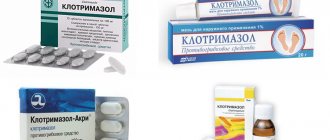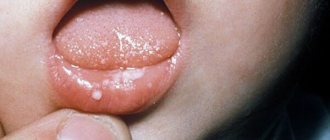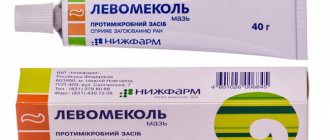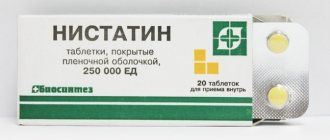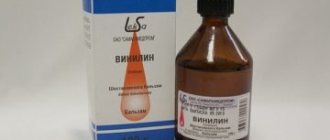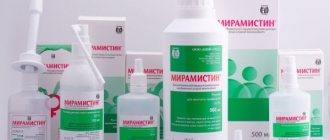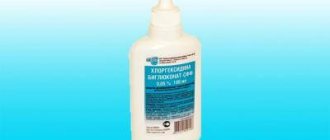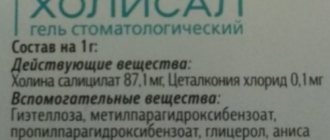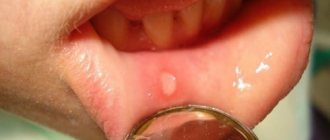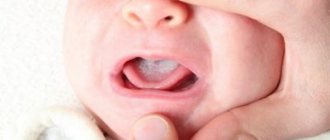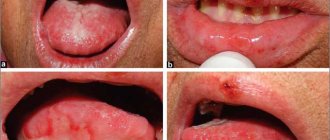Directions for use and dosage
Many mothers start using Candide without doctor's recommendations. This is very dangerous, because the child may react to the drug with an allergy, which in the worst case will lead to Quincke's edema. If the baby develops irritation during treatment, then therapy should be stopped. For candidal stomatitis, it is recommended to use additional medications that will help achieve maximum effect. For the treatment of children, Candide powder and solution are indicated for use.
All forms of the drug should not be applied to the skin around the eyes. During treatment, it is important to constantly monitor the condition of the little patient. This is especially true for those who suffer from liver failure. Other application features:
- if hypersensitivity reactions develop during treatment, then therapy for candidiasis should be stopped;
- if there is no effect within 4 weeks, you should consult a doctor to confirm the diagnosis;
- The medicine does not in any way affect driving or operating precision machinery.
Candida for the oral cavity
For candidiasis, this drug is used in the form of a solution to treat the oral cavity. About 10-20 drops, which equals 0.5-1 ml, are applied to the affected areas of the mucous membrane using a cotton swab. The effect of treatment appears 3-5 days after the start of treatment, but therapy should be continued until the signs of candidiasis completely disappear. For newborns, use 5-10 drops on a surface of 5-6 cm. The frequency of application of the solution is 2 times a day. For prevention, use of the medicine is continued for another 2 weeks after the symptoms disappear.
Candide powder
The powder is indicated for external use. It is applied to the affected areas of the skin up to 3-4 times daily. It must first be washed with soap and dried. According to the instructions, regularity of treatment is very important. The severity of the disease and the location of the lesions determine the duration of therapy. In general, treatment lasts until symptoms are completely relieved. The average duration is about 4 weeks. In the case of pityriasis versicolor, the course of treatment is 1-3 weeks, and for erythrasma - 2-4 weeks. The powder can be used instead of the solution as follows:
- take a glass of water, dissolve 5 mg of powder in it;
- shake or stir well;
- apply to the lesions with a cotton swab;
- repeat 3-4 times daily.
Features of the drug
The main component of the drug is clotrimazole, an imidazole derivative. 1 ml of the drug contains 10 mg of active substance. Additionally, the drops include glycerol and propylene glycol.
Clotrimazole penetrates the cell membrane of pathogenic microorganisms, disrupts its structure and the synthesis of ergosterol. It is effective against:
- yeast-like and mold fungi;
- causative agent of pityriasis versicolor and erythrasma;
- gram-negative and gram-positive bacteria.
The main active ingredient is clotrimazole.
Important! In small doses, the medication has a fungistatic effect (slows down the proliferation of pathogenic microorganisms), in large doses it has a fungicidal effect (leads to the death of microbes). However, this does not mean that you need to use the medicine without measure. The same Candida fungi are considered opportunistic. Their complete absence will lead to an imbalance of the local microflora.
The oral solution is for external use only. It is almost not absorbed into the mucous membrane and does not penetrate the bloodstream. Accidental ingestion of small doses is possible, but is not advisable.
Candide for newborns
Indications for the use of Candida in newborns are candidal stomatitis and thrush. A positive effect is noted after the first use. Pediatricians recommend this medication from the first days of life, because the drug does not have a negative effect on babies. The instructions for the solution indicate that Candide is not used for thrush in newborns. Restriction on use is age less than 2 years. For this reason, the medicine is used in newborns only under medical supervision.
The use of Candida in dentistry
There are several forms of Candida: solution or drops, cream, powder, vaginal tablets and gel. In dental practice, only a solution is used.
"Candide" for the oral cavity is a transparent, viscous substance without color or odor. Sold in 15 ml bottles. The average price is 260 – 320 rubles.
The medicine tastes bitter.
Additional Information! The medicine is bitter. Therefore, the baby may be capricious and not allow the affected areas to be treated.
Typically, the medication is prescribed for oral thrush or candidal stomatitis, which often occurs in newborns. However, it will also be effective from:
- any form of stomatitis caused by viruses and fungi;
- cheilitis;
- gingivitis;
- angulitis;
- glossitis.
Side effects
Judging by patient reviews, the medicine is well tolerated, but in some cases side effects are possible. They manifest themselves in the form of the following symptoms:
- erythema;
- swelling;
- blisters;
- skin irritation;
- itching;
- the appearance of burning and tingling at the site of use;
- peeling.
According to the instructions for use, vaginal tablets are not used to treat children. Side effects from this form are rare. If this happens, local irritation of the vaginal mucosa is noted, which disappears after self-treatment. When used intravaginally, the following reactions are possible:
- headache;
- burning and itching;
- pain during sexual intercourse;
- vaginal discharge, swelling of the mucous membrane;
- burning sensation in the genitals of a man;
- frequent urination;
- intercurrent cystitis.
Clotrimazole for the treatment of oral candidiasis
Diseases caused by a group of pathogenic fungi are quite common in the world. It has now been established that the main cause of mycoses is a decrease in the resistance of the macroorganism, associated with a weakening of local and general immunity.
The therapeutic effect on pathogenic microorganisms must be complex, including both systemic antimycotic drugs and local therapy. One of the drugs that is widely used in medical practice is Clotrimazole.
In the article you will see detailed instructions for using clotrimazole solution against fungus of nails, skin and mucous membranes.
There are several therapeutic forms of release of the drug:
- Solution for external use (Clotrimazole, Candide);
- Gel (Clotrimazole);
- Ointment (Clotrimazole);
- Tablets and suppositories intended for insertion into the vagina (Candide B6, Clotrimazole);
- Cream (Canesten).
To prevent Clotrimazole from losing its therapeutic properties, it must be stored in a dry place that is not exposed to direct sunlight . It is optimal to store the drug at a temperature of +15 to +25 degrees. The medicine should not be freely available where children can take it.
The main substance that has a therapeutic effect is clotrimazole, an antimycotic agent from the group of imidazole derivatives, which has a wide spectrum of action. A 1% solution contains 10 mg of medication in 1 ml of product, sold in 15 ml bottles. Auxiliary components are polyethylene glycol 400, propylene glycol, ethanol in 96% concentration. The drug is effective against the following pathogens:
- Fungi from the genus dermatomycetes (Trichophyton rubrum, T. interdigitale, Microsporum spp., Epidermophyton floccosum);
- Gram-positive flora: staphylococci and streptococci;
- Gram-negative flora: bacteroides and gardnerella;
- Yeasts from the genus Candida (mainly C. albicans).
The drug disrupts the structure of the fungal cell wall, reduces the activity of peroxidase enzymes, which leads to the accumulation of hydrogen peroxide inside the cell, which causes its destruction. Depending on the concentration of the drug, Clotrimazole has a fungicidal (destructive) or fungistatic (growth-stopping) effect on the microorganism.
This medicine is widely used in the treatment of fungal diseases that primarily affect the skin and mucous membranes. However, Clotrimazole can also be used in case of onychomycosis. It is approved for use in the following diseases:
- Dermatophytosis;
- Trichophytosis;
- Microsporia;
- Erythrasmas;
- Fungal paronychia, including those affecting the interdigital spaces;
- Candidal stomatitis (damage to the oral cavity), vulvovaginitis (damage to the mucous membrane of the vulva and vagina), balanitis (fungus infection of the foreskin and glans penis);
- Lichen versicolor;
- Trichomoniasis, affecting the genitourinary system.
The drug is used strictly externally. Before applying to the skin, wash the area with soap and dry thoroughly. A single dose for application to the surface of the body should be sufficient to completely treat the affected area.
Approximately 10-20 drops of a solution of 1% concentration are used on a palm-sized area of skin . The medicine is applied in a thin layer evenly over the entire affected surface 2-3 times a day, gently rubbed in, allowed to be absorbed without wearing clothes for some time.
The course of treatment for fungal infections of the skin and mucous membranes is 4 weeks, lichen versicolor – 1-2 weeks. For mycosis of the feet, after the symptoms of the disease disappear, treatment must be continued for another 2 weeks.
Application of clotrimazole solution for the oral cavity
If oral candidiasis occurs, apply 10-20 drops of the product (0.5 or 1 ml, respectively) to the affected areas using a cotton swab 3-4 times a day. After the drug has been applied, it is not recommended to eat for 1 hour so that the medicine has time to take effect.
In most cases, improvement is observed on days 3-5 of using the drug. Treatment is continued until clinical manifestations disappear.
How to use the solution for onychomycosis
Before using the product, the nail plates are thoroughly washed with water and soap and then dried. The drug is applied in a thin layer to each nail plate affected by the fungus and the skin of the finger around it 2-3 times a day. The duration of treatment is 4 weeks.
The main reason why it is not recommended to use Clotrimazole is hypersensitivity to the components of the drug or to the main active substance. Also, clotrimazole solution should not be taken during the 1st trimester of pregnancy, as it has a negative effect on the fetus.
The following side effects may occur while taking the drug:
- When applied to the skin: local redness, even erythema, blistering, local swelling, tingling, skin irritation, itching;
- When used in the oral cavity: redness of the mucous membranes, burning sensation, tingling sensation;
- When applied to the mucous membranes of the genitals: itching, burning, swelling of tissues, symptoms of cystitis, pain during sexual intercourse;
- Various allergic reactions.
When used simultaneously with polyene antifungal agents (Nystatin, Amphotericin-B, Natamycin), Clotrimazole reduces their effectiveness.
When applying the solution to the affected areas, care must be taken to ensure that the drug does not come into contact with the mucous membrane of the eyes. It is not recommended to apply the drug to damaged skin, or under an airtight bandage.
In case of accidental ingestion of the solution, the following symptoms may occur:
- Nausea, vomiting;
- Pain in the abdomen;
- Rarely – increased number of urinations, the appearance of hallucinations, feelings of drowsiness and allergic skin rashes.
For local treatment of fungal diseases of the nail plate, agents from the allylamine group - Terbinafine and Naftifine in the form of creams - are widely used. Drugs from the azole group are also popular - Fluconazole and Itraconazole, available in the form of ointments and creams. Just like Clotrimazole, they have a detrimental effect on pathogenic microorganisms.
To combat oral candidiasis, polyene antibiotics are used - Nystatin, Levorin and Amphoglucamine. Fluconazole is also widely used. These drugs have a systemic effect and are available in the form of tablets that must be chewed and kept in the mouth for a long time to obtain the effect.
Now you know how to use clotrimazole solution against fungus of nails, skin and mucous membranes.
Leave your reviews about the drug in the comments.
Based on materials from gribkostop.ru
Clotrimazole is used for the oral cavity as a broad-spectrum fungicidal agent. Its substance clotrimazole also has antibacterial, antiprotozoal and trichomonacid properties. Therefore, the drug can be used in combination for other pathologies whose pathogens are sensitive to clotrimazole. When treating diseases in the oral cavity, you must follow the rules for using the medicine.
The direct indication for Clotrimazole (or a product with the active ingredient clotrimazole) is candidal stomatitis, which is often called thrush. The doctor can also include the drug in a complex therapy regimen for the development of other infectious pathologies in the mouth.
It is possible to add Clotrimazole to basic treatment medications:
- bacterial stomatitis;
- lichen planus on the lips and/or mouth;
- secondary cheilitis (against the background of fungal, bacterial diseases);
- mycotic glossitis;
- oral dysbiosis (with a predominance of fungi, streptococcus, and other bacteria);
- purulent glossitis.
To treat diseases of the oral cavity, use the form of Clotrimazole whose indications include the disease “candidal stomatitis”. This product is approved for treating the tongue, gums, lips, palate, and inner surface of the cheeks, and does not cause poisoning.
For the oral cavity, Clotrimazole is used for external use in the form of:
It is prohibited to treat the oral cavity in the form of an ointment or cream with Clotrimazole. They are prescribed only for infectious pathologies of the skin, nails, beard, and head.
Important! The appearance of areas of inflammation, ulcers, lumps or white spots in the mouth also occurs with the development of STIs and sexually transmitted diseases, the pathogens of which enter the mucous membrane during oral sex. Since the substance clotrimazole acts only on fungi, trichomonas, dermatomycetes, some protozoa and bacteria, the drug should be used only as prescribed by a doctor after examination and analysis of a smear or scraping.
Clotrimazole disrupts the production of pathogen components and its metabolism. In the mouth, the substance begins to act after half an hour, suppressing growth and causing the death of the pathogen. The degree of therapeutic effect depends on the concentration. Clotrimazole gel and solution contain 1% clotrimazole, which is enough to kill fungi.
Clotrimazole is applied morning and evening. First, in the area of the source of infection, plaque is removed from the oral mucosa with a gauze swab moistened with Chlorhexidine 0.05%. Then the area is blotted with a dry bandage. Rub gel or 10–20 drops of solution onto the cleaned shell in the area of the outbreak and around it with a cotton swab (no need to dilute). After treatment in the oral cavity, you should not drink or eat for 2 hours .
Local treatment with Clotrimazole should be carried out for 7 days, even if the symptoms of thrush disappeared on the 3rd day. Sometimes, after improvement occurs, doctors allow you to switch to a single application of an antifungal agent. If at the end of a week-long course of therapy there is no result, a microbiological examination must be done again.
On a note! When treating thrush in a baby, the mother needs to wash her breasts with a soda solution after each feeding of the baby, as well as pacifiers and rodent toys.
Clotrimazole should not be used by people with hypersensitivity to clotrimazole and by pregnant women in the 1st trimester. If during treatment a persistent burning sensation, hyperemia or other local irritation appears in the mouth, the drug is replaced with another drug: an allergy to the active substance is also a contraindication.
In children, treatment of the oral cavity with Clotrimazole is allowed, since the drug has no age restrictions. In the 2nd–3rd trimester of pregnancy, the drug must be used strictly according to the treatment regimen developed by the doctor: high doses of clotrimazole have an embryotoxic effect. The ability of the substance to penetrate breast milk has not been studied, therefore lactating women are recommended to transfer the child to artificial nutrition during the period of treatment of candidiasis.
For the oral cavity, Clotrimazole can be replaced with other antifungal drugs with the active ingredient clotrimazole. Of the direct analogues, it is allowed to use Kanison, Candid, Candizol (cream), Candibene.
Vidal : https://www.vidal.ru/drugs/clotrimazole__7002 GRLS : https://grls.rosminzdrav.ru/Grls_View_v2.aspx?routingGuid=32297fe2-0ddb-4b7c-9af9-acb6183a8e12&t=
Found a mistake? Select it and press Ctrl + Enter
Based on materials from pillsman.org
Thrush (candidiasis) is an infectious disease that affects the mucous membranes of the body. If fungal microflora progresses in the oral cavity, then we are talking about oral candidiasis. This is accompanied by the development of discomfort and loss of taste. If treatment is not treated in a timely manner, serious complications arise. What effective remedies exist for oral candidiasis? How to properly approach the treatment of fungal infections of the oral mucosa?
OUR READERS RECOMMEND!
Thrush develops due to a decrease in the body's protective functions. The immune system can independently fight fungus or bacteria, but only when it is in a normal state. When the resistance of the protective barrier decreases, pathogenic microflora in the body, including fungus, progresses.
Most often, oral candidiasis is diagnosed in women during pregnancy. In men, this disease is very rare. Smoking is a predisposing factor in this case, since tobacco smoke disrupts the natural microflora of the oral cavity.
Thrush is an infectious disease that can be transmitted from one person to another: through kissing, sexual contact, and even through household contact, when using other people’s hygiene products.
- Persons using removable dentures.
- Taking corticosteroids by inhalation.
- Undergoing antibacterial or hormonal therapy.
- People who take drugs and abuse alcohol.
- HIV infected.
More than anything else, the development of candidiasis in an adult is facilitated by damage to the mucous membrane.
How to treat thrush in the mouth? It all depends on what stage the disease is at. The severity of fungal infection of the mucous membrane can be determined by the symptoms of the disease. To confirm the diagnosis, it is necessary to undergo a series of laboratory tests. After receiving the results of the diagnosis, the doctor will make a conclusion and prescribe effective drug therapy.
It is permissible to use traditional medicine in the initial stages of candidiasis progression or as a supportive method for a speedy recovery when using medications. Self-medication can cause the fungal disease to progress, which causes serious complications.
Types of oral candidiasis in adults:
- Pseudomembranous (acute). It is characterized by the appearance of a white cheesy coating on the lips, palate, tongue and cheeks. Under the thick, dense coating is reddened, smooth mucous membrane. There are cracks (jams) in the corners of the lips. There is an increase in the submandibular lymph nodes. The disease resembles diseases such as stomatitis, diphtheria and tonsillitis.
- Atrophic (acute). Develops mainly when wearing dentures. The mucous membrane dries out, a burning sensation and pain appear. The mucous membrane becomes red and shiny. The papillae on the tongue atrophy. A cheesy coating appears in the fold area. It is removed with great difficulty.
- Hyperplastic (chronic). It manifests itself as pain that occurs when eating spicy and sour foods. The mucous membrane dries out and becomes covered with gray plaques. When they are removed, ulcers and a papular rash form on the palate, cheeks or tongue. There are no signs of general intoxication.
- Atrophic (chronic). Characterized by the appearance of cracks in the corners of the lips. Dry mucous membranes provoke pain while eating. The entire oral cavity is hyperemic. A cheesy coating appears in the folds in the area of the upper palate, which is easily removed and leaves no traces behind.
The acute stage of thrush is easy to cure. If drug therapy is started in a timely manner, treatment takes no more than 7-10 days. In the case of the chronic form of the disease, things are different. Treatment must be comprehensive and long-term. In some cases it takes 1-3 months.
If you have thrush in your mouth, then you should not delay visiting the doctor. Only by taking timely measures can you cure a fungal disease quickly and eliminate the likelihood of relapses.
If the following symptoms appear, you should immediately go to your doctor:
- Burning and itching in the mouth.
- Swallowing dysfunction.
- Impaired taste perception.
- The appearance of a solid or dotted white coating.
- Development of signs of intoxication of the body: weakness, increased body temperature, headaches.
It is important to correctly determine what kind of disease we are talking about. In order to differentiate thrush from stomatitis or tonsillitis, you should pay attention to the fact that the cheesy plaque during candidiasis decreases when treating the oral cavity with soda. In this case, there are foci of inflammation and ulcers on the mucous membrane.
To prescribe effective remedies for oral candidiasis, you need to contact a dentist, mycologist or infectious disease specialist. You can also visit a therapist to provide primary care. Additional examination by an allergist or endocrinologist may be required.
The specialist conducts diagnostics and makes an accurate diagnosis. After determining the type of pathogen and the nature of the fungal infection of the oral mucosa, drug therapy is prescribed.
Thrush in the mouth of an adult in the initial stages of progression can be stopped with the help of special antimycotic lozenges. Among the most effective drugs are Diflucan, Lysozyme and Clotrimazole.
Solutions to relieve symptoms and stop the progression of an infectious disease are very popular. Among the most effective against oral candidiasis are Amphotericin and Decamine. The oral cavity can be lubricated with brilliant green or Lugol, which also helps relieve the symptoms of candidiasis.
Antimycotic aerosols containing hexoral or chlorhexidine are highly effective. Swallowing such drugs is unacceptable, so they should be used with caution.
You can treat the mucous membrane with solutions such as baking soda and borax. These remedies eliminate the acidic environment, replacing it with an alkaline one, which helps relieve the symptoms of the disease and prevents its progression. For these purposes, you can use potassium permanganate. The number of procedures per day should be at least five. The course of therapy depends on the degree of disease progression.
How to rinse your mouth for candidiasis at home? Medications have a number of contraindications and can cause adverse reactions. In some cases, for example, during pregnancy, their use is highly undesirable. What to do in such a situation? If there is no predisposition to developing allergies, then you can use traditional therapy, the effectiveness of which has been tested by time.
Thrush in the mouth can be cured very quickly. To do this you need to use essential oils. Among the most effective are:
To carry out the procedure, just add 5-7 drops of essential oil to 200 ml of water. 3-5 rinses should be done per day. After the symptoms of the disease disappear, treatment should not be stopped. Cleansing procedures should be carried out for another 3-5 days.
Simple vegetables can be used to treat oral candidiasis. This method is the most accessible and inexpensive. Vegetables contain substances that have a pronounced antiseptic and antifungal effect. Among the most effective vegetables and berries against fungal microflora are:
- Garlic and onion.
- Carrots, viburnum and cranberries.
In order to treat oral thrush, you need to prepare juice from the products listed above. They treat the affected areas 3-5 times a day. The course of treatment depends on the extent of the damage. Even if the symptoms of the disease disappeared 2-3 days after the start of treatment, you should not stop therapy. The course of using vegetable and berry juice is at least 7 days.
The preferred method of folk treatment for thrush is the use of medicinal plants. They comprehensively combat the problem of fungal infection of the mucous membranes. On their basis, infusions and decoctions are prepared, which can be used to wash or irrigate the mucous membrane. Fight candidiasis with medicinal herbs and rinse.
To prepare a medicinal infusion and decoction, it is recommended to take 1 tbsp per 200 ml of boiling water. l. dry crushed raw materials. The resulting solution should be infused for 1-2 hours or simmered in a water bath for 30 minutes. It is recommended to rinse your mouth 5 times a day for 7-10 days.
Among the most effective medicinal herbs are:
- St. John's wort and calendula.
- Oak bark and wild rosemary.
The recommended dosage should not be exceeded, as this may cause a serious allergic reaction.
The treatment procedure should be carried out only after the mucous membrane has been cleansed of cheesy plaque. This increases the effectiveness of the remedies used, speeding up the healing process.
Among the generally accepted remedies are:
- Honey. With its help, the oral cavity is treated and kept on the mucous membrane until completely dissolved.
- Natural oils (rosehip, sea buckthorn). A napkin soaked in oil is applied to the areas of the mucous membrane affected by the fungus for 5-10 minutes, depending on the degree of progression of the disease.
The duration of alternative therapy using applications is 1.5-2 weeks. After the symptoms of the disease subside, treatment should be continued. This approach eliminates the possibility of relapses.
If the disease is in a chronic stage, then local medications or folk remedies will not work. The doctor must prescribe systemic medications.
Among the most popular and effective medications against oral candidiasis are:
- Polyenes (Natamycin, Levorin and Nystatin).
- Echinocandins (“Caspofugin”).
- Allylamines (Lamisil and Terbinafine).
- Triazoles ("Intraconazole" and "Fluconazole").
The effectiveness of these drugs is aimed at destroying fungal microflora throughout the body. Medicines are taken orally, after which the active substances penetrate the bloodstream and suppress the activity of the thrush pathogen. This treatment gives faster and more lasting results.
Please note that all of the drugs listed above have a number of contraindications and can cause serious complications. That is why a preliminary consultation with a doctor is mandatory.
In order to select the most effective remedy for the treatment of oral thrush, it is necessary to undergo diagnostics. Only an experienced doctor, based on the results obtained, can prescribe the most effective and safe therapy.
What to do?
How to defeat the infection without harming yourself?
The famous blogger Irina Kravtsova became hostage to the disease and told us about the most effective home method for getting rid of thrush in 14 days!
Read the article >>>
Based on materials from netmolochnici.ru
Contraindications
An absolute contraindication to all forms of release is hypersensitivity or individual intolerance to the active component of the drug clotrimazole. The same applies to excipients in the composition of the medicine. Other contraindications:
- first trimester of pregnancy;
- with caution during lactation.
Do not apply the powder or solution to areas where there is a violation of the integrity of the skin. This applies to the following types of wounds:
- scratches;
- abrasions;
- bleeding;
- sores.
Analogs
Today, pharmaceuticals offer many drugs with a similar composition or effect. The price of analogs is determined by the manufacturer, release form and place of purchase. Among the drugs similar to Candida are the following:
- Kandibene;
- Imidyl cream;
- Antifungol;
- Candizol;
- Amyclone;
- Clotrimazole;
- Candide-B6;
- Kanesten;
- Candide B.
Symptoms
Representatives of the genus Candida are capable of reproducing on absolutely any tissue within their habitat: on the surface of the cheeks, tonsils, tongue, in the area of the corners of the lips or on their border. Depending on the location, it is customary to distinguish forms of the disease that differ slightly in symptoms. In order to begin timely treatment of oral candidiasis, it is necessary to learn to identify its first signs and successfully differentiate them from other pathologies.
A symptom that is characteristic of any variant of the disease can provide serious assistance in primary diagnosis. This is the presence of a specific coating on the mucous membranes and skin, which allows one to suspect the presence of “thrush” even during a cursory examination.
We suggest you familiarize yourself with Bad Breath
In the case of a short course of the disease, the formations that appear on the mucous membrane have a “curdled” white color. The surface of the plaque often shines when illuminated, which simplifies the process of detecting deposits in the area of the tongue root. The appearance of such formations is point-like, with a certain distance of one focus from another.
But after 5-8 days they begin to merge and form a single layer (“crust”).
If pathological foci are removed by cutting after their formation, a clean surface of the mucous membrane will remain at the site of the defect, without noticeable damage. This operation does not require much effort, and you can use a regular spoon or medical spatula as a tool. In the case of a prolonged course, candidal overlays undergo the following changes:
- the color of the formations changes and acquires a dirty gray or yellowish tint, due to the formation of protein filaments from fibrin contained in the “crusts”;
- It becomes quite difficult to clean the mucous membrane on your own, since the fungus begins to penetrate deep into normal tissues. An additional obstacle to cleansing is the formation of the fibrin skeleton;
- When candidal formations are separated, damaged epithelium begins to appear, with the presence of pinpoint bleeding and individual tissue defects.
These pathological formations can occupy both a local area (tonsils, surface of the tongue) and the entire cavity. Other signs of oral candidiasis are of additional importance, but they are also important to take into account in order to make the correct final diagnosis and reduce the risk of diagnostic error.
Candida price
The cost of the drug will vary in different pharmacies. In addition, the price of the medicine is different for each release form. The approximate cost for Moscow is shown in the table:
| Place of purchase | Release form | Volume | Price, rubles |
| 366.ru | Powder 1% | 30 g | 313 |
| Cream 1% | 20 g | 246 | |
| Solution 1% | 20 ml | 351 | |
| Pharmacy IFC | Solution 1% | 15 ml | 298 |
| Candid-B6, tablets | 6 pcs. | 67 | |
| Cream 1% | 20 g | 358 | |
| Powder 1% | 30 g | 445 |
